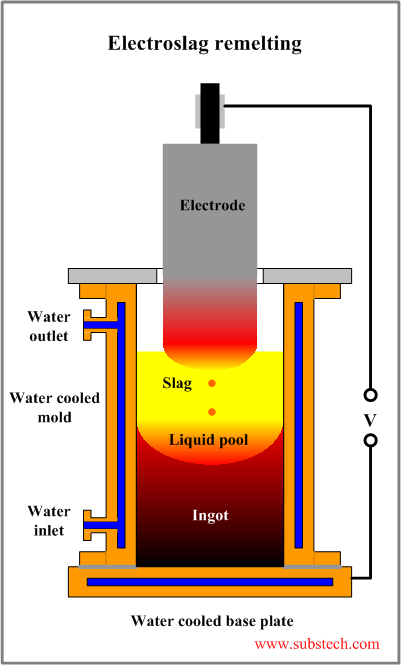to Metals
to Steel making
Electroslag Remelting
Dr. Dmitri Kopeliovich
Electroslag Remelting (ESR) is a process of remelting a consumable electrode utilizing the heat generated by an electric current passing through a molten slag between the electrode and the solidifying ingot.
ESR process description
 The consumable electrods are as cast or forged cylindrical parts made of an alloy to be remelt.
The consumable electrods are as cast or forged cylindrical parts made of an alloy to be remelt.
An electroslag remelting process (ESR) starts when the lower tip of a consumable electrode is immersed into a pool of molten slag.
The premelted slag possessing electrical conductivity is located on the water-cooled mold base connected to a power supply.
The electric current (commonly AC) passing through the the slag keeps it at high temperature, which is about 360ºF (200ºC) higher than the melting point of the remelted metal.
The electrode tip is heated by the hot slag and starts to melt forming droplets of liquid metal, which disconnect from the electrode and sink through the slag layer.
The slag composition is based on calcium fluoride (CaF2), lime (CaO) and alumina (Al2O3).
The slag composition provides the following properties:
- Melting point lower than that of the remelted alloy;
- Required level ov viscosity;
- Required level of electrical conductivity;
- High solubility of sulfur;
- Capability to adsorb non-metallic inclusions.
The molten steel in form of both liquid film on the electrode tip and descending droplets contacts with the slag and get refined due to desulfurization and removal of non-metallic inclusions (sulfides and oxides).
The droplets enters the molten steel pool, bottom of which is progressively solidifying. The water-cooled copper mold provides relatively high gradient of temperature resulting in high solidification rate. Solidification front is moving upwards (unidirectional solidification) forming sound homogeneous metal structure.
The ingot has a good surface quality due to a thin slag film covering it.
to top
Advantages of Electroslag Remelting
- Deep desulfurization;
- Refining non-metallic inclusions;
- Homogeneous Distribution of non-metallic inclusions
- Fine Grain structure;
- No Shrinkage defects;
- Low macrosegregation;
- Good surface quality;
- Controllable process.
Applications of Electroslag Remelting
- Superalloys (nickel base alloys possessing high strength, Creep resistance and oxidation resistance at high temperatures.
- Large Forging ingots. Fabrication of large steel ingots requires technologies providing high purity steel with low level of macrosegregation and shrinkage porosity. The technology of electroslag remelting (ESR) meets these demands. Ingots up to 200 metric tons are produced by electroslag remelting utilizing simultaneous remelting of tens of electrodes. The ingots are used for manufacturing heavy parts for electric power generating units (turbine shafts, generator rotor shafts).
- Rolling mill rolls.
- Titanium alloys for aerospace applications.
- Titanium scrap remelting. Titnanium machining turnings and foundry scrap may be recycled by ESR providing cost effective secondary titanium.
Electroslag Remelting under controllable atmosphere
- Electroslag Remelting under vacuum. The main limitation of the conventional ESR process is difficulty of removal of hydrogen exerting adverse effect on mechanical properties of steels. Low content of Hydrogen in conventional ESR is obtained by control of hydrogen in the consumable electrode. Additionally Electroslag Remelting under atmospere may cause oxidation by Oxygen penetrating into the slag contacting the pool of liquid metal. Electroslag Remelting under vacuum provides both vacuum degassing and oxidation protection of the remelted metal.
- Electroslag Remelting under inert gas atmosphere. Inert gas protects the slag and the metal from oxidation and from pick-up of atmospheric hydrogen. The method is simpler and cheaper than ESR under vacuum but it does not allow hydrogen removal.
- Electroslag Remelting under increased pressure. The method is used for remelting nitride hardened steels (alloyed by Nitrogen). During ESR process such steels are continuously alloyed by nitrogen containing compounds. Increased pressure prevents removal of dissolved nitrogen from the liquid steel to the atmosphere.
Related internal links
to Metals
to Steel making